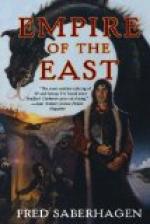Next day we came again, and took a picture of our genial friend, whom we found seated and playing the gusla to a crowd of other prisoners, some exceedingly heavily chained.
One or two guards came up and we spent an hour in a pleasant chat.
Our friend was only “in” for a few days for making a rude remark about the Chief of Police. The chained men were mostly murderers, if we may use such a harsh term for those who are compelled to kill their enemies by the relentless laws of the vendetta, and who would be punished by the laws of man should they prove themselves guilty of cowardice.
The vendetta in Montenegro is a legal anomaly. Men are punished in either case.
CHAPTER XVIII
S. Vasili and Ostrog—Our drive thither—Joyful pilgrims—Varied costumes—We meet the Vladika of Montenegro—The ordeal of hot coffee—A real pilgrimage—The shrine of S. Vasili—The ancient hermit—A miracle—Niksic—The gaudy cathedral and the Prince’s palace—We are disappointed in Niksic.
Though we visited the famous Monastery of Ostrog at the very beginning of our visit to Montenegro, and Niksic at the conclusion, both places lie so near together that we put them now in this order for the sake of simplicity.
It was our good fortune to be enabled to witness the annual pilgrimage to the shrine of S. Vasili, which takes place during the Greek Whitsuntide.
Ostrog is the Lourdes of the Balkans, as many equally miraculous cures take place as at the Roman Catholic rival in the Pyrenees. The Serb-speaking races from far and near flock there in enormous numbers, as well as many Mahometans and Catholics.
S. Vasili (or Basil) was a native of the Hercegovina and a holy man of great repute. About a century ago he had a vision telling him to travel to Montenegro, and there to found a monastery. Accordingly he set out, taking with him a great quantity of building material, and chose a spot not far from Podgorica, on the right bank of the Zeta. But in the night the material disappeared, and S. Vasili hunted high and low. After a weary search it was found at Ostrog, and there he built his place of retreat, living many years, working many miracles, and dying as a saint. He is buried there, and it is said that any believer has but to visit the shrine, and whatever his wish may be, it will be fulfilled. Thus cripples have walked back the way which they were carried, sick have been made whole, and the mentally afflicted have gone away rejoicing. Certain it is that many wonderful cures are yearly effected there.
Furthermore, the name of Ostrog appears often in the glorious annals of Montenegrin history. The oft-told tale of Prince Nicolas’ father, Mirko, “The Sword of Montenegro,” who was besieged in that inaccessible cleft in a precipice with a handful of men, is one of the most famous feats of Montenegrin arms. The charred cliffs still bear silent witness to the efforts which the Turks made to burn out the little garrison by throwing bundles of flaming straw from above.




